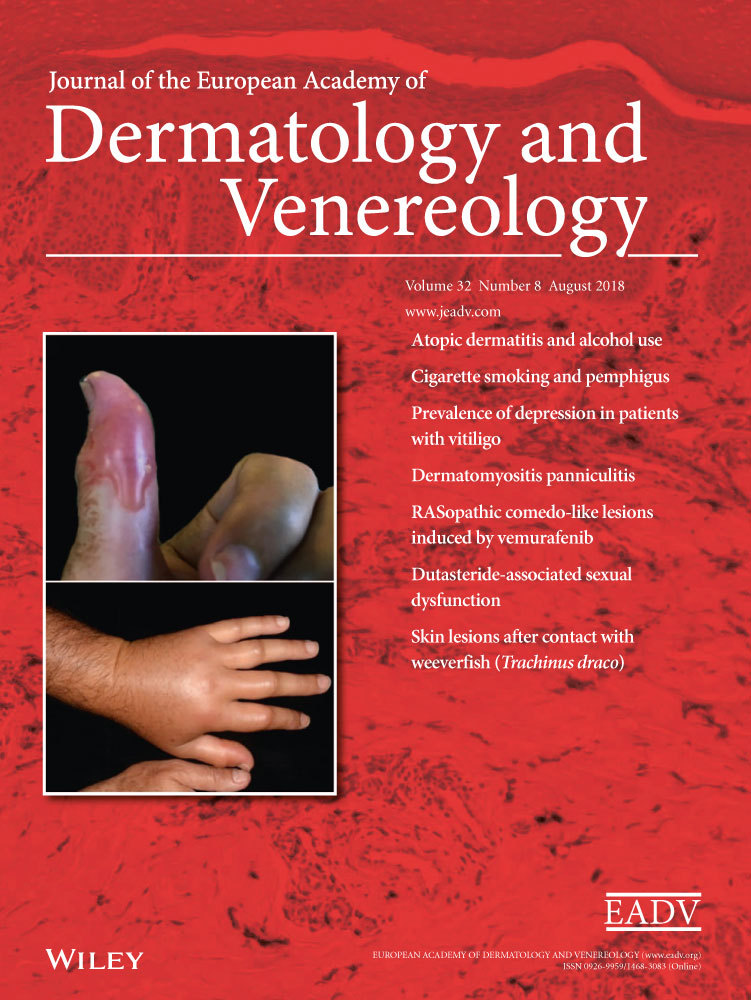CYLD mutations differentially affect splicing and mRNA decay in Brooke–Spiegler syndrome
L.J.M.T. Parren
Department of Dermatology, Jeroen Bosch Hospital, ‘s-Hertogenbosch, The Netherlands
Department of Dermatology, Maastricht University Medical Center (MUMC), Maastricht, The Netherlands
GROW – School for Oncology and Developmental Biology, Maastricht University Medical Center (MUMC), Maastricht, The Netherlands
Search for more papers by this authorJ.M. Baron
Department of Dermatology and Allergology, RWTH Aachen University, Aachen, Germany
Search for more papers by this authorS. Joussen
Institute of Physiology, RWTH Aachen University, Aachen, Germany
Search for more papers by this authorY. Marquardt
Department of Dermatology and Allergology, RWTH Aachen University, Aachen, Germany
Search for more papers by this authorM.A.M. van Steensel
Institute of Medical Biology, Immunos, Singapore, Singapore
Division of Cancer Science, College of Medicine, Dentistry and Nursing, University of Dundee, Dundee, UK
Department of Biological Chemistry and Drug Discover, College of Life Sciences, University of Dundee, Dundee, UK
Search for more papers by this authorP.M. Steijlen
Department of Dermatology, Maastricht University Medical Center (MUMC), Maastricht, The Netherlands
GROW – School for Oncology and Developmental Biology, Maastricht University Medical Center (MUMC), Maastricht, The Netherlands
Search for more papers by this authorM. van Geel
Department of Dermatology, Maastricht University Medical Center (MUMC), Maastricht, The Netherlands
GROW – School for Oncology and Developmental Biology, Maastricht University Medical Center (MUMC), Maastricht, The Netherlands
Department of Clinical Genetics, Maastricht University Medical Center, Maastricht, The Netherlands
Search for more papers by this authorCorresponding Author
J. Frank
Department of Dermatology, Venereology and Allergology, University Medical Center Göttingen, Göttingen, Germany
Correspondence: J. Frank. E-mail: [email protected]Search for more papers by this authorL.J.M.T. Parren
Department of Dermatology, Jeroen Bosch Hospital, ‘s-Hertogenbosch, The Netherlands
Department of Dermatology, Maastricht University Medical Center (MUMC), Maastricht, The Netherlands
GROW – School for Oncology and Developmental Biology, Maastricht University Medical Center (MUMC), Maastricht, The Netherlands
Search for more papers by this authorJ.M. Baron
Department of Dermatology and Allergology, RWTH Aachen University, Aachen, Germany
Search for more papers by this authorS. Joussen
Institute of Physiology, RWTH Aachen University, Aachen, Germany
Search for more papers by this authorY. Marquardt
Department of Dermatology and Allergology, RWTH Aachen University, Aachen, Germany
Search for more papers by this authorM.A.M. van Steensel
Institute of Medical Biology, Immunos, Singapore, Singapore
Division of Cancer Science, College of Medicine, Dentistry and Nursing, University of Dundee, Dundee, UK
Department of Biological Chemistry and Drug Discover, College of Life Sciences, University of Dundee, Dundee, UK
Search for more papers by this authorP.M. Steijlen
Department of Dermatology, Maastricht University Medical Center (MUMC), Maastricht, The Netherlands
GROW – School for Oncology and Developmental Biology, Maastricht University Medical Center (MUMC), Maastricht, The Netherlands
Search for more papers by this authorM. van Geel
Department of Dermatology, Maastricht University Medical Center (MUMC), Maastricht, The Netherlands
GROW – School for Oncology and Developmental Biology, Maastricht University Medical Center (MUMC), Maastricht, The Netherlands
Department of Clinical Genetics, Maastricht University Medical Center, Maastricht, The Netherlands
Search for more papers by this authorCorresponding Author
J. Frank
Department of Dermatology, Venereology and Allergology, University Medical Center Göttingen, Göttingen, Germany
Correspondence: J. Frank. E-mail: [email protected]Search for more papers by this author
References
- 1Ancell H. History of a remarkable case of tumours developed on the head and face; accompanied with a similar disease in the abdomen. Med Chir Trans 1842; 25: 227–246.
- 2Nagy N, Farkas K, Kemény K, Széll M. Phenotype-genotpe correlations for clinical variants caused by CYLD mutations. Eur J Med Genet 2015; 58: 271–278.
- 3Fujii A, Matsuyama K, Mizutani Y, Kanoh H, Nakona H, Sishima M. Multiple familial trichoepithelioma with a novel mutation of the CYLD gene. J Dermatol 2017; 44: e228–e229.
- 4Duparc A, Lasek-Duriez A, Wiart T, Duban-Bedu B, Gosset P, Modiano P. Multiple familial trichoepithelioma: a new CYLD gene mutation. Ann Dermatol Venereol 2013; 140: 274–277.
- 5Massoumi R. Ubiquitin chain cleavage: CYLD at work. Trends Biochem Sci 2010; 35: 392–399.
- 6Iliopoulos D, Jaeger SA, Hirsch HA, Bulyk ML, Struhl K. STAT3 activation of miR-21 and miR-181b-1 via PTEN and CYLD are part of the epigenetic switch linking inflammation to cancer. Mol Cell 2010; 39: 493–506.




